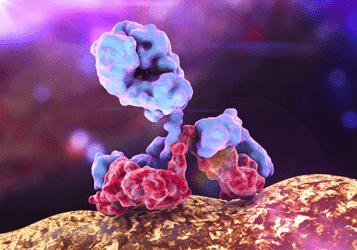- Home
- Products
- Customized ADCs
- CD22
- Anti-CD22-Mc-MMAF ADC-9
Anti-CD22-Mc-MMAF ADC-9 (CAT#: ADC-W-217)
This ADC product is comprised of an anti-CD22 monoclonal antibody (clone 10F4v3) conjugated via a Mc linker to MMAF. The MMAF is targeted to certain cancers by immunerecognition and delivered into cancer cells via receptor mediated endocytosis. Within the cell, MMAF binds to tubulins, interrupts microtubule dynamics, and subsequently, induces cell death.
- ADC Target
- ADC Antibody
- ADC Linker
- ADC payload drug
- Name
- CD22
- Alternative Names
- CD22; CD22 molecule; SIGLEC2; SIGLEC-2; B-cell receptor CD22; BL-CAM; CD22 antigen; T-cell surface antigen Leu-14; B-lymphocyte cell adhesion molecule; sialic acid binding Ig-like lectin 2; sialic acid-binding Ig-like lectin 2;
- Target Entrez Gene ID
- 933
- Target UniProt ID
- P20273
- Overview
- CD22, or cluster of differentiation-22, is a molecule belonging to the SIGLEC family of lectins. It is found on the surface of mature B cells and to a lesser extent on some immature B cells. Generally speaking, CD22 is a regulatory molecule that prevents the overactivation of the immune system and the development of autoimmune diseases. CD22 is a sugar binding transmembrane protein, which specifically binds sialic acid with an immunoglobulin (Ig) domain located at its N-terminus. The presence of Ig domains makes CD22 a member of the immunoglobulin superfamily. CD22 functions as an inhibitory receptor for B cell receptor (BCR) signaling. It is also involved in the B cell trafficking to Peyer's patches in mice.
- Overview
- Humanized Anti-CD22 lgG1 Antibody, 10F4v3
- Generic name
- 10F4v3
- Species Reactivity
- Human
- Name
- Mc (maleimidocaproyl)
- Description
- Noncleavable linkers, is considered noncleavable-meaning linker cleavage, and payload release does not depend on the differential properties between the plasma and some cytoplasmic compartments. Instead, the release of the cytotoxic drug is postulated to occur after internalization of the ADC via antigen-mediated endocytosis and delivery to lysosomal compartment, where the antibody is degraded to the level of amino acids through intracellular proteolytic degradation.
- Name
- MMAF (Monomethyl auristatin F)
- Description
- Derived from Auristatin,are water-soluble dolastatin analogs of dolastatin 10. Dolastatin 10 belongs to dolastatin family and it can powerfully bind to tubulin, thus inhibiting polymerization mediated through the binding to the vinca alkaloid binding domain, and causes cell to accumulate in metaphase arrest.
For Research Use Only. NOT FOR CLINICAL USE.
Related Products
- Anti-CD70-bac-MMAF ADC-3 (CAT#: ADC-W-361)
- Anti-C. diff Toxin A (Actoxumab)-MC-Vc-PAB-SN38 ADC (CAT#: ADC-W-2052)
- Anti-CD70-MC-Vc-PAB-MMAE ADC-7 (CAT#: ADC-W-953)
- Anti-RhD (Roledumab)-MC-Vc-PAB-DMEA-(PEG2)-duocarmycin SA ADC (CAT#: ADC-W-1735)
- Anti-CD40LG (Ruplizumab)-MC-Vc-PAB-MMAE ADC (CAT#: ADC-W-917)
- Anti-EGFR (Nimotuzumab)-MC-Vc-PAB-SN38 ADC (CAT#: ADC-W-1062)
- Anti-CTLA4 (Ticilimumab)-MC-Vc-PAB-MMAE ADC (CAT#: ADC-W-1007)
- Anti-TNFRSF17-VC-MMAE ADC-5 (CAT#: ADC-W-266)
- Anti-FGFR2-sulfo-SMCC-DM1 ADC-8 (CAT#: ADC-W-058)
- Anti-CD74-Mc-MMAF ADC-2 (CAT#: ADC-W-040)
Published Data
+ Submit Publications

Scientific Resources
Customer Reviews and FAQs
There are currently no Customer reviews or questions for ADC-W-217. Click the button above to contact us or submit your feedback about this product.
Quick Links
Other Products
Same Target
Same Linker
Same Payload
| CAT# | Product Name | Linker | Payload |
| ADC-W-2536 | Anti-CD22 (Pinatuzumab)-MC-Vc-PAB-DMEA-(PEG2)-duocarmycin SA ADC | MC-Vc-PAB-DMEA-(PEG2) | duocarmycin SA |
| ADC-W-484 | Anti-CD22-MCC-DM1 ADC-11 | MCC (Maleimidomethyl cyclohexane-1-carboxylate) | DM1 (N2’-Deacetyl-N2’-(3-mercapto-1-oxopropyl)maytansine) |
| ADC-W-2531 | Anti-CD22-MC-Vc-PAB-DMEA-(PEG2)-duocarmycin SA ADC | MC-Vc-PAB-DMEA-(PEG2) | duocarmycin SA |
| ADC-W-2533 | Anti-CD22 (Pinatuzumab)-SPDB-DM4 ADC | SPDB (N-succinimidyl-4-(2-pyridyldithio)butyrate) | DM4 (N2'-Deacetyl-N2'-(4-mercapto-4-methyl-1-oxopentyl)maytansine) |
| ADC-W-2535 | Anti-CD22 (Pinatuzumab)-MC-Vc-PAB-SN38 ADC | MC-Vc-PAB (maleimidocaproyl-valine-citrulline-p-aminobenzoyloxycarbonyl) | SN-38 (7-ethyl-10-hydroxycamptothecin) |
| CAT# | Product Name | Linker | Payload |
| ADC-W-2612 | Anti-MS4A1 (Rituximab)-MC-MMAF ADC | MC (maleimidocaproyl) | MMAF |
| ADC-W-518 | Anti-TM4SF1-Mc-LP2 ADC-2 | Mc (maleimidocaproyl) | LP2 (chemical name mc-3377) |
| ADC-W-114 | Anti-CD33-Mc-MMAF ADC-3 | Mc (maleimidocaproyl) | MMAF (Monomethyl auristatin F) |
| ADC-W-115 | Anti-CD33-Mc-MMAF ADC-1 | Mc (maleimidocaproyl) | MMAF (Monomethyl auristatin F) |
| ADC-W-515 | Anti-EGFR-Mc-MMAF ADC-5 | Mc (maleimidocaproyl) | MMAF (Monomethyl auristatin F) |
| CAT# | Product Name | Linker | Payload |
| ADC-AA-019 | anti-MIgG(Fc)-N-MMAF ADC | Noncleavable linkers | MMAF (Monomethyl auristatin F) |
| ADC-W-537 | Anti-TPBG-Mc-MMAF ADC | Mc (maleimidocaproyl) | MMAF (Monomethyl auristatin F) |
| ADC-W-493 | Anti-CD19-Mc-MMAF ADC-3 | Mc (maleimidocaproyl) | MMAF (Monomethyl auristatin F) |
| ADC-AA-002 | anti-HIgG(Fc)-C-MMAF ADC | Cleavable linkers | MMAF (Monomethyl auristatin F) |
| ADC-W-515 | Anti-EGFR-Mc-MMAF ADC-5 | Mc (maleimidocaproyl) | MMAF (Monomethyl auristatin F) |
Online Inquiry
Welcome! For price inquiries, please feel free to contact us through the form on the left side. We will get back to you as soon as possible.



